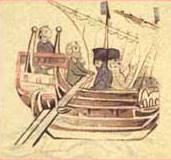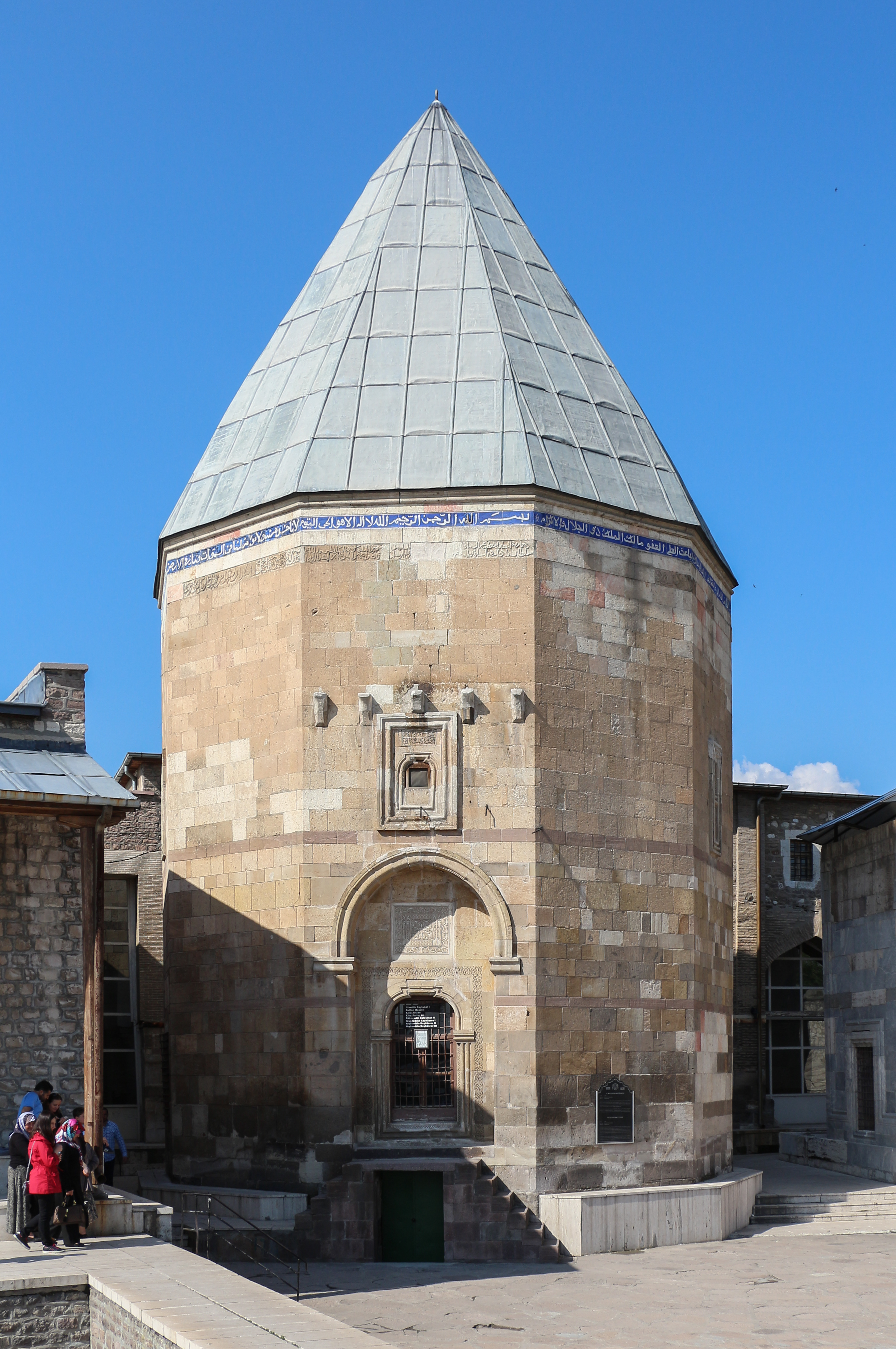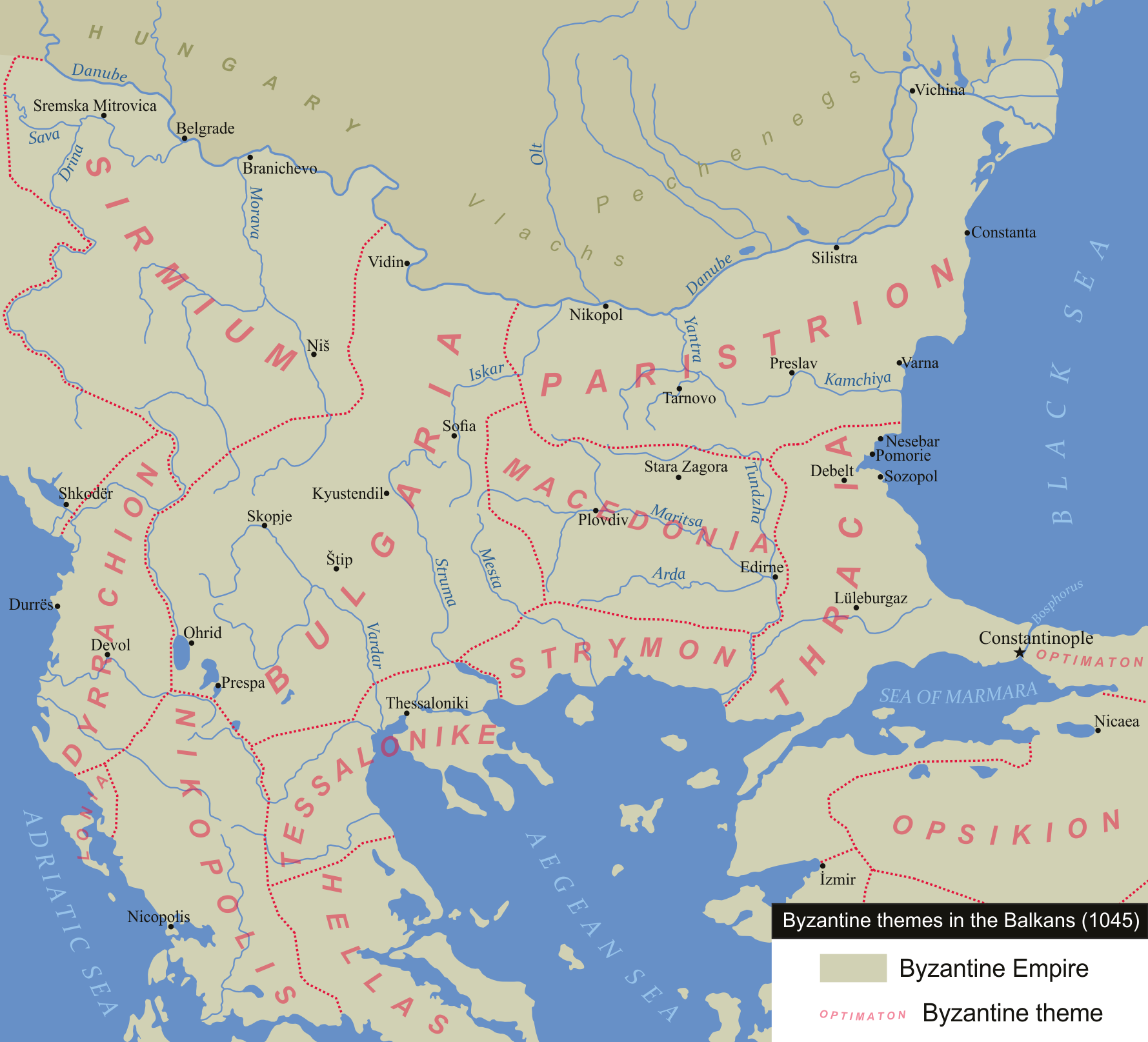|
1190
Year 1190 ( MCXC) was a common year starting on Monday (link will display the full calendar) of the Julian calendar. Events By place Byzantine Empire * Spring – A German expeditionary force (some 15,000 men) led by Emperor Frederick I (Barbarossa) marches towards Constantinople, on the way to the Holy Land. Emperor Isaac II (Angelos), suspicious that Frederick is planning to conquer Constantinople, attempts to stop him by attacking the Crusaders. The German forces are too strong and they capture Adrianople. A peace treaty is signed by both Isaac and Frederick, that ensures the Germans are given supplies, and free passage through to Palestina. * Isaac II starts a campaign against the Bulgarians, who claim their independence. After passing the Balkan Mountains, Isaac marches westward to besiege Tarnovo, the new Bulgarian capital. Meanwhile, the Byzantine fleet reaches the Danube River in order to block the way of Cuman reinforcements from the North. The defense o ... [...More Info...] [...Related Items...] OR: [Wikipedia] [Google] [Baidu] |
Frederick I, Holy Roman Emperor
Frederick Barbarossa (December 1122 – 10 June 1190), also known as Frederick I (german: link=no, Friedrich I, it, Federico I), was the Holy Roman Emperor from 1155 until his death 35 years later. He was elected King of Germany in Frankfurt on 4 March 1152 and crowned in Aachen on 9 March 1152. He was crowned King of Italy on 24 April 1155 in Pavia and emperor by Pope Adrian IV on 18 June 1155 in Rome. Two years later, the term ' ("holy") first appeared in a document in connection with his empire. He was later formally crowned King of Burgundy, at Arles on 30 June 1178. He was named by the northern Italian cities which he attempted to rule: Barbarossa means "red beard" in Italian; in German, he was known as ', which means "Emperor Redbeard" in English. The prevalence of the Italian nickname, even in later German usage, reflects the centrality of the Italian campaigns to his career. Frederick was by inheritance Duke of Swabia (1147–1152, as Frederick III) before his i ... [...More Info...] [...Related Items...] OR: [Wikipedia] [Google] [Baidu] |
Battle Of Philomelion (1190)
The Battle of Philomelion (Philomelium in Latin, Akşehir in Turkish) was a victory of the forces of the Holy Roman Empire over the Turkish forces of the Sultanate of Rûm on 7 May 1190 during the Third Crusade. In May 1189, Holy Roman Emperor Frederick Barbarossa began his expedition to the Holy Land as part of the Third Crusade to recover the city of Jerusalem from the forces of Saladin. After an extended stay in the European territories of the Byzantine Empire, the Imperial army crossed over to Asia at the Dardanelles from 22–28 March 1190. After surmounting opposition from Byzantine populations and Turkish irregulars, the Crusader army was surprised in camp by a 10,000-man Turkish force of the Sultanate of Rûm near Philomelion on the evening of 7 May. The Crusader army counterattacked with 2,000 infantry and cavalry under the leadership of Frederick VI, Duke of Swabia and Berthold, Duke of Merania, putting the Turks to flight and killing 4,174–5,000 of them. Backgroun ... [...More Info...] [...Related Items...] OR: [Wikipedia] [Google] [Baidu] |
Conrad Of Montferrat
Conrad of Montferrat (Italian: ''Corrado del Monferrato''; Piedmontese: ''Conrà ëd Monfrà'') (died 28 April 1192) was a nobleman, one of the major participants in the Third Crusade. He was the ''de facto'' King of Jerusalem (as Conrad I) by virtue of his marriage to Isabella I of Jerusalem from 24 November 1190, but officially elected only in 1192, days before his death. He was also the eighth Marquess of Montferrat from 1191. Early life Conrad was the second son of Marquess William V of Montferrat, "the Elder", and his wife Judith of Babenberg. He was a first cousin of Frederick Barbarossa, Holy Roman Emperor, as well as Louis VII of France and Leopold V of Austria. Conrad was born in Montferrat, which is now a region of Piedmont, in northwest Italy. The exact place and year are unknown. He is first mentioned in a charter in 1160, when serving at the court of his maternal uncle, Conrad, Bishop of Passau, later Archbishop of Salzburg. (He may have been named after him, or af ... [...More Info...] [...Related Items...] OR: [Wikipedia] [Google] [Baidu] |
Battle Of Tryavna
The Battle of Tryavna ( bg, Битка при Трявна) occurred in 1190, in the mountains around the contemporary town of Tryavna, central Bulgaria. The result was a Bulgarian victory over the Byzantine Empire, which secured the successes achieved since the beginning of the Rebellion of Asen and Peter in 1185. Origins of the conflict After his second campaign in Moesia and the fruitless siege of Lovech in 1187, the Byzantine Emperor Isaac II Angelos was forced to conclude a truce, thus ''de facto'' recognizing the independence of Bulgaria. Until 1189, both sides observed the truce. The Bulgarians used this time to further organize their administration and military. When the soldiers of the Third Crusade reached the Bulgarian lands at Niš, Asen and Peter offered to help the Emperor of the Holy Roman Empire, Frederick I Barbarosa, with a force of 40,000 against the Byzantines. However, the relations between the Crusaders and the Byzantines smoothed, and the Bulgarian p ... [...More Info...] [...Related Items...] OR: [Wikipedia] [Google] [Baidu] |
Kilij Arslan II
Kilij Arslan II ( 1ca, قِلِج اَرسلان دوم) or ʿIzz ad-Dīn Kilij Arslān ibn Masʿūd ( fa, عز الدین قلج ارسلان بن مسعود) (Modern Turkish ''Kılıç Arslan'', meaning "Sword Lion") was a Seljuk Sultan of Rûm from 1156 until his death in 1192. Reign As Arnold of Lübeck reports in his ''Chronica Slavorum'', he was present at the meeting of Henry the Lion with Kilij-Arslan during the former's pilgrimage to Jerusalem in 1172. When they met near Tarsus, the sultan embraced and kissed the German duke, reminding him that they were blood cousins ('amplexans et deosculans eum, dicens, eum consanguineum suum esse'). When the duke asked for details of this relationship, Kilij Arslan informed him that 'a noble lady from the land of Germans married a king of Russia who had a daughter by her; this daughter's daughter arrived to our land, and I descend from her.' In 1159, Kilij Arslan attacked Byzantine emperor Manuel I Comnenus as he marched past Icon ... [...More Info...] [...Related Items...] OR: [Wikipedia] [Google] [Baidu] |
Cumans
The Cumans (or Kumans), also known as Polovtsians or Polovtsy (plural only, from the Russian language, Russian Exonym and endonym, exonym ), were a Turkic people, Turkic nomadic people comprising the western branch of the Cuman–Kipchak confederation. After the Mongol invasion of Rus', Mongol invasion (1237), many sought Right of asylum, asylum in the Kingdom of Hungary, as many Cumans had settled in Hungary, the Second Bulgarian Empire playing an important role in the development of the state. Cumans played also an important role in (The Byzantine Empire, the Latin Empire, and the Empire of Nicaea, Nicaea Empire) Anatolia . Related to the Pecheneg, they inhabited a shifting area north of the Black Sea and along the Volga River known as Cumania, from which the Cuman–Kipchaks meddled in the politics of the Caucasus and the Khwarazmian Empire. The Cumans were fierce and formidable nomadic warriors of the Eurasian Steppe who exerted an enduring influence on the medieval Balkans. ... [...More Info...] [...Related Items...] OR: [Wikipedia] [Google] [Baidu] |
Sultanate Of Rum
fa, سلجوقیان روم () , status = , government_type = Hereditary monarchyTriarchy (1249–1254)Diarchy (1257–1262) , year_start = 1077 , year_end = 1308 , p1 = Byzantine Empire under the Doukas dynastyByzantine Empire , p2 = Seljuk Empire , p3 = Danishmends , p4 = Mengujekids , p5 = Saltukids , p6 = Artuqids , s1 = Anatolian beyliks , s2 = Ilkhanate, , event_pre = Battle of Manzikert , date_pre = 1071 , event_start = Division from the Seljuk Empire , event1 = Battle of Köse Dağ , date_event1 = 1243 , event_end = Karamanid conquest , image_flag = Double-headed eagle of the Sultanate of Rum.svg , flag_size = 100px , flag_type = ... [...More Info...] [...Related Items...] OR: [Wikipedia] [Google] [Baidu] |
Isaac II Angelos
Isaac II Angelos or Angelus ( grc-gre, Ἰσαάκιος Κομνηνός Ἄγγελος, ; September 1156 – January 1204) was Byzantine Emperor from 1185 to 1195, and again from 1203 to 1204. His father Andronikos Doukas Angelos was a military leader in Asia Minor (c. 1122 – aft. 1185) who married Euphrosyne Kastamonitissa (c. 1125 – aft. 1195). Andronikos Doukas Angelos was the son of Constantine Angelos and Theodora Komnene (b. 15 January 1096/1097), the youngest daughter of Emperor Alexios I Komnenos and Irene Doukaina. Thus Isaac was a member of the extended imperial clan of the Komnenoi. Rising by revolt Niketas Choniates described Isaac's physical appearance: "He had a ruddy complexion and red hair, was of average height and robust in body". During the brief reign of Andronikos I Komnenos, Isaac was involved (alongside his father and brothers) in the revolt of Nicaea and Prousa. Atypically, the Emperor did not punish him for this disloyalty, an ... [...More Info...] [...Related Items...] OR: [Wikipedia] [Google] [Baidu] |
Ivan Asen I Of Bulgaria
Ivan Asen I, also known as Asen I or John Asen I ( bg, Иван Асен I; died in 1196), was emperor or tsar of Bulgaria from 1187/1188 to 1196 as co-ruler with his elder brother, Peter II. Hailing from the Byzantine theme of Paristrion, his exact place and date of birth are unknown. Although most contemporaneous chronicles describe Asen and his brothers, Theodor (Peter) and Kaloyan, as Vlachs, they were probably of mixed Vlach, Bulgarian, and Cuman ancestry. In 1185, Asen and Theodor went to see the Byzantine Emperor Isaac II Angelos in Thrace to demand an estate in the Balkan Mountains. After the Emperor refused and humiliated them, the brothers persuaded their Bulgarian and Vlach compatriots to rise up against the Byzantine Empire. Before the end of the year, Theodor was crowned Emperor of Bulgaria, taking the name Peter. After Isaac II defeated them in early 1186, Asen and Peter fled north over the Danube but returned in the autumn, accompanied by Cuman reinforcements. Th ... [...More Info...] [...Related Items...] OR: [Wikipedia] [Google] [Baidu] |
Second Bulgarian Empire
The Second Bulgarian Empire (; ) was a medieval Bulgarians, Bulgarian state that existed between 1185 and 1396. A successor to the First Bulgarian Empire, it reached the peak of its power under Tsars Kaloyan of Bulgaria, Kaloyan and Ivan Asen II before gradually being conquered by the Ottoman Empire, Ottomans in the late 14th century. Until 1256, the Second Bulgarian Empire was the dominant power in the Balkans, defeating the Byzantine Empire in several major battles. In 1205, Emperor Kaloyan defeated the newly established Latin Empire in the battle of Adrianople (1205), Battle of Adrianople. His nephew Ivan Asen II defeated the Despotate of Epiros and made Bulgaria a regional power again. During his reign, Bulgaria spread from the Adriatic Sea, Adriatic to the Black Sea and the economy flourished. In the late 13th century, however, the Empire declined under constant invasions by Mongols, Byzantine Empire, Byzantines, Hungarians, and Serbia in the Middle Ages, Serbs, as well as i ... [...More Info...] [...Related Items...] OR: [Wikipedia] [Google] [Baidu] |
Balkan Mountains
The Balkan mountain range (, , known locally also as Stara planina) is a mountain range in the eastern part of the Balkan Peninsula in Southeastern Europe. The range is conventionally taken to begin at the peak of Vrashka Chuka on the border between Bulgaria and Serbia. It then runs for about , first in a south-easterly direction along the border, then eastward across Bulgaria, forming a natural barrier between the northern and southern halves of the country, before finally reaching the Black Sea at Cape Emine. The mountains reach their highest point with Botev Peak at . In much of the central and eastern sections, the summit forms the watershed between the drainage basins of the Black Sea and the Aegean. A prominent gap in the mountains is formed by the sometimes narrow Iskar Gorge, a few miles north of the Bulgarian capital, Sofia. The karst relief determines the large number of caves, including Magura, featuring the most important and extended European post-Palaeolithic cave ... [...More Info...] [...Related Items...] OR: [Wikipedia] [Google] [Baidu] |
Tryavna
Tryavna ( bg, Трявна ) is a town in central Bulgaria, situated in the northern slopes of the Balkan range, on the Tryavna river valley, near Gabrovo. It is famous for its textile industry and typical National Revival architecture, featuring 140 cultural monuments, must and expositions. Tryavna is the birthplace of Bulgarian writer Pencho Slaveykov and revolutionary Angel Kanchev. The town is the administrative centre of the eponymous Tryavna Municipality. As of December 2009, it has a population of 9,831 inhabitants. History The village was founded as early as the Thracian Era. However, the first documents of its existence date back to the 12th century. In 1190 it was the site of the Battle of Tryavna, which proved crucial in reestablishing Bulgarian independence from the Byzantines. During Ottoman Bulgaria period locals defended the pass and enjoyed privileges for this reason. Only Bulgarians lived in the town. During the period of Bulgarian National Revival, the town ... [...More Info...] [...Related Items...] OR: [Wikipedia] [Google] [Baidu] |






